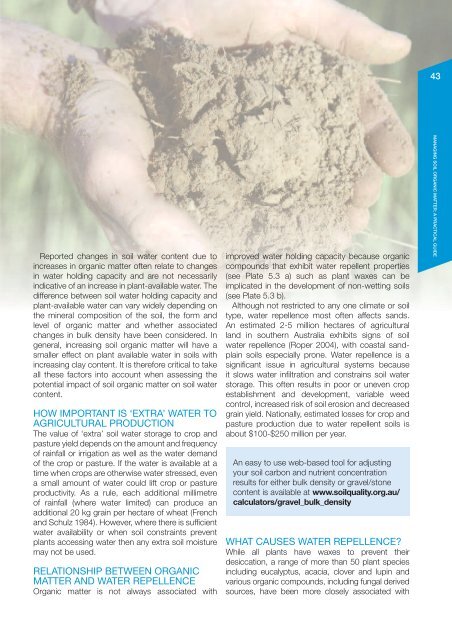managing soil organic matter - Grains Research & Development ...
managing soil organic matter - Grains Research & Development ...
managing soil organic matter - Grains Research & Development ...
Create successful ePaper yourself
Turn your PDF publications into a flip-book with our unique Google optimized e-Paper software.
43Reported changes in <strong>soil</strong> water content due toincreases in <strong>organic</strong> <strong>matter</strong> often relate to changesin water holding capacity and are not necessarilyindicative of an increase in plant-available water. Thedifference between <strong>soil</strong> water holding capacity andplant-available water can vary widely depending onthe mineral composition of the <strong>soil</strong>, the form andlevel of <strong>organic</strong> <strong>matter</strong> and whether associatedchanges in bulk density have been considered. Ingeneral, increasing <strong>soil</strong> <strong>organic</strong> <strong>matter</strong> will have asmaller effect on plant available water in <strong>soil</strong>s withincreasing clay content. It is therefore critical to takeall these factors into account when assessing thepotential impact of <strong>soil</strong> <strong>organic</strong> <strong>matter</strong> on <strong>soil</strong> watercontent.HOW IMPORTANT IS ‘EXTRA’ WATER TOAGRICULTURAL PRODUCTIONThe value of ‘extra’ <strong>soil</strong> water storage to crop andpasture yield depends on the amount and frequencyof rainfall or irrigation as well as the water demandof the crop or pasture. If the water is available at atime when crops are otherwise water stressed, evena small amount of water could lift crop or pastureproductivity. As a rule, each additional millimetreof rainfall (where water limited) can produce anadditional 20 kg grain per hectare of wheat (Frenchand Schulz 1984). However, where there is sufficientwater availability or when <strong>soil</strong> constraints preventplants accessing water then any extra <strong>soil</strong> moisturemay not be used.RELATIONSHIP BETWEEN ORGANICMATTER AND WATER REPELLENCEOrganic <strong>matter</strong> is not always associated withimproved water holding capacity because <strong>organic</strong>compounds that exhibit water repellent properties(see Plate 5.3 a) such as plant waxes can beimplicated in the development of non-wetting <strong>soil</strong>s(see Plate 5.3 b).Although not restricted to any one climate or <strong>soil</strong>type, water repellence most often affects sands.An estimated 2-5 million hectares of agriculturalland in southern Australia exhibits signs of <strong>soil</strong>water repellence (Roper 2004), with coastal sandplain<strong>soil</strong>s especially prone. Water repellence is asignificant issue in agricultural systems becauseit slows water infiltration and constrains <strong>soil</strong> waterstorage. This often results in poor or uneven cropestablishment and development, variable weedcontrol, increased risk of <strong>soil</strong> erosion and decreasedgrain yield. Nationally, estimated losses for crop andpasture production due to water repellent <strong>soil</strong>s isabout $100-$250 million per year.An easy to use web-based tool for adjustingyour <strong>soil</strong> carbon and nutrient concentrationresults for either bulk density or gravel/stonecontent is available at www.<strong>soil</strong>quality.org.au/calculators/gravel_bulk_densityWHAT CAUSES WATER REPELLENCE?While all plants have waxes to prevent theirdesiccation, a range of more than 50 plant speciesincluding eucalyptus, acacia, clover and lupin andvarious <strong>organic</strong> compounds, including fungal derivedsources, have been more closely associated withMANAGING SOIL ORGANIC MATTER: A PRACTICAL GUIDE
















